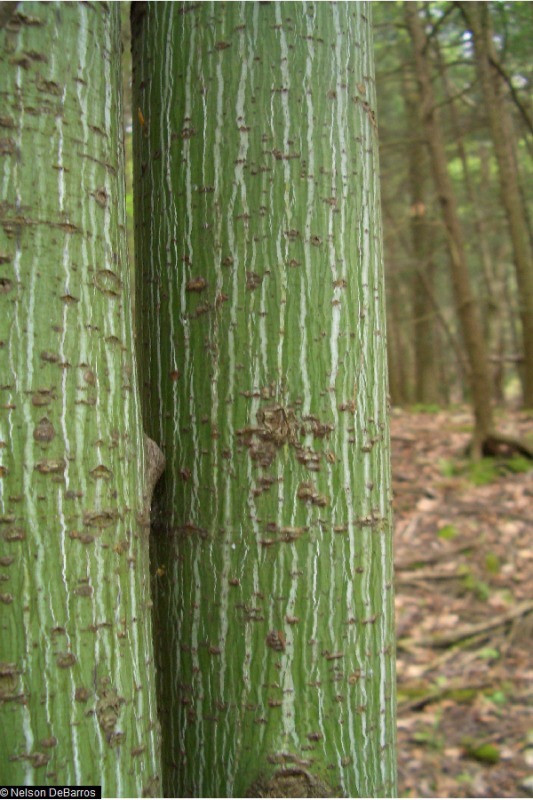|

Green and white striped bark of the striped maple. (DeBarros, 2014).
|
There are many different types of maple trees, and it can be difficult to tell some of the species apart. Fortunately, the striped maple is quite distinctive!
As previously mentioned, the striped maple is typically an understory tree and therefore does not grow very large or quickly. While it can grow as tall as 40 feet, the typical height is around 25 feet, and the spread of the leafy crown is less than or equal to its height. In fact, the striped maple is sometimes referred to as a shrub, probably because of its short stature and understory status. However, it is worth noting that in Maine’s Register of Big Trees, there are two entries for striped maples: one that stands 45 feet tall and one that has reached 50 feet in height.
One of the most distinctive aspects of this tree is its bark. Thin and much smoother than the bark of most maples, its vertical green and white stripes give the striped maple its name. The stripes are not straight but rather tend to undulate back and forth like a snake in motion — giving the tree another of its common names: the snakebark maple. These stripes form after the tree is 2 years old, and they begin to fade as the tree gets older, turning a greenish brown or red.
Another easily distinguishable characteristic of the bark is that the tips of the smaller stems and the buds, although green in the summer months, turn red in the winter. Between the stripes and the red-tipped branches, the striped maple is easily identified even in winter.
Like all trees in the Acer genus, the maple has opposite leaves, meaning that they grow in pairs, one on each side of the twig. Large and simple, with three lobes, a length of 5 to 6 inches, and a finely toothed edge, the leaves are very recognizable. Their shape is similar to the foot of a very large duck or goose, leading to one of the tree’s other common names: goosefoot maple. The leaves are pale green in color and turn a light yellow in the fall.
The buds of the striped maple grow where the stem of the leaf connects to the branch. They are smooth, less than ½ inch long, and blunt at the tip. At the tip of each branch is a terminal bud, which, at about ½ inch long, is just slightly longer than the other buds.
|